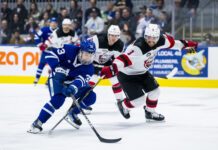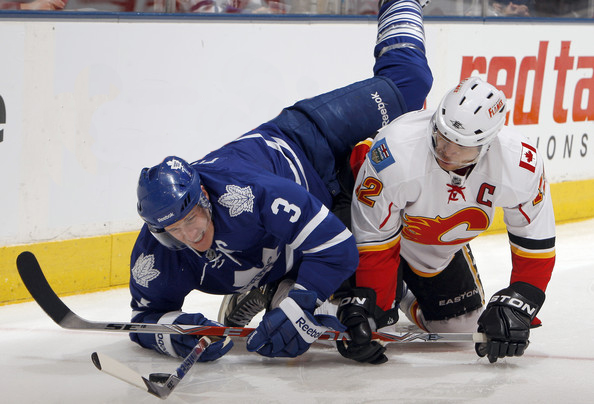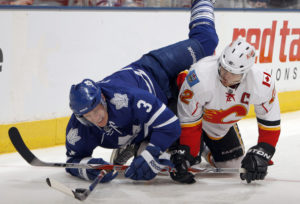
Last week’s review focused on the Leafs‘ top 6 forwards, while the week before that saw us take a peek at the bottom 6’s production. Now we’ll switch our attention to the defence, which always seems so promising before the season starts and it crumbles to pieces. Again, we’re only counting players that skated in at least 20 games for the Leafs, leaving us with seven players: Cody Franson, Jake Gardiner, Dion Phaneuf, John-Michael Liles, Carl Gunnarsson, Luke Schenn and Mike Komisarek.
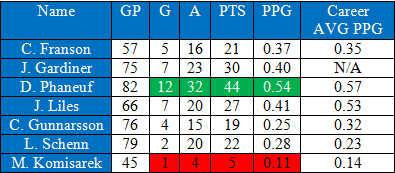
All things considered, the Leafs received a considerable amount of offence from their back end this season. With the exception of Liles, most players hovered around their career averages and Franson managed to surpass his. Franson’s numbers are more impressive when you consider that he’s been on the bottom pairing virtually every game. Phaneuf garnered a lot of hatred in the media this year, most of which was completely unfounded due to his finishing 12th in defensive scoring in 2011-12. With the exception of Erik Karlsson in Ottawa, the players above Phaneuf in scoring had similar stat lines. John-Michael Liles ended up finishing with the lowest point total of his career, including his rookie year in 2003-04. Yikes.
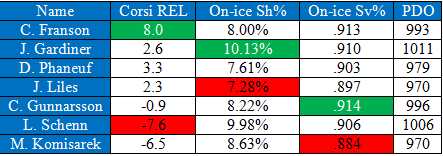
Cody Franson immediately pops out as having a pretty decent Corsi rating for a defenceman. Gardiner, Phaneuf and Liles all have positive Corsi ratings, as they should. Corsi is of course based on attempted shots for and against, so there will always be a bias towards offensively minded players. This explains Gunnarsson’s slightly negative Corsi, as his primary goal on the ice for the Leafs is to stop the opposition. After having done so, Gunnarsson is adept at getting the puck up ice. This has led to, as noted above, an only slightly negative Corsi. In contrast, Luke Schenn and Mike Komisarek often get pinned in their own end, unable to move the puck to their forwards. This is reflected in their extremely poor ratings.
It also explains their on-ice save percentages in comparison to Gunnarsson. While Gunnarsson does not often get pinned in his own end, the goalie behind him will have a more evenly distributed workload. With Schenn and Komisarek, the goalie is under constant pressure for at least a full minute in extreme cases, leading to more mistakes and goals against. As for the shooting percentages, they’re all over the place, but most are within an expected range. Jake Gardiner’s extremely high on-ice shooting percentage is due in equal parts to his magnificent passing and sometimes frustrating tendency to look for reasons not to shoot. He’s just a rookie, so there is still lots of time to coach a more offensive minded approach into him.

It should come as no surprise to Leafs fans to see Komisarek leading the way in penalties against. His extremely slow, baffling decisions on the ice are somewhat impressive in their own right. Gunnarsson and Gardiner occupy the opposite end of the spectrum, which can be attributed to Gunnarsson’s discipline and Gardiner’s lack of physicality, respectively. The zone starts for Schenn are interesting in that he’s over 50% in that regard. For a “defensive” defenceman, that high an offensive zone start percentage is never a good sign. Gunnarsson and even Komisarek are well below Schenn, in ranges normally expected for defensive minded players. The only conclusion is that the Leafs have lost faith in him and were attempting to shelter him. Despite that, he still managed to be well below average in most regards. Not a good sign at all.
The only area which can be seen as a positive for Schenn is in his hitting. His total of 270 puts him at 7th in the NHL in that regard. Here’s the problem in my eyes: hitting is not a positive in its own right, but a positive bonus on top of other desirable traits. You don’t keep someone around for hits alone. If two players are equally excellent at scoring, you take the bigger, harder hitting player every time. Schenn has managed to regress every single season in the NHL so far, to the point now where he can be expected to hit things and little more.
Phaneuf has, in lieu of the constant scorn thrust upon him, had a pretty fantastic season for the blue and white. He was second on the defensive corps in hits, second in blocked shots and drew the most penalties. He had the most goals, assists and points among d-men on the Leafs, finishing 12th in defensive scoring. He did all of this while only starting exactly half of his shifts in the offensive end, meaning he was relied upon equally at both ends of the ice. Incredibly, his PDO ends up at a very low 979, meaning a jump in either on-ice shooting or save percentage is likely next season (probably the latter). I can’t speak to his leadership in the dressing room, but he sure led on the ice.
This brings us to John-Michael Liles. He played quite well for a large chunk of the season. From October 6th to December 22nd, he amassed 21 points. One concussion later at the hands of Paul Gaustad and Liles finished with 6 more points from February 1st to April 7th. Despite this, the Leafs made the baffling decision to re-sign him while he was still on the IR. So the Leafs may have just extended a player for four more years who is now broken. Yikes again.
Finally, I want to talk a short while about a new advancement in statistical analysis for defencemen. Steve Burtch over at the Pension Plan Puppets has concocted something he calls the Shut Down Index (SDI). If you want the juicy details, I suggest reading his article, but essentially it uses Corsi REL QoC/QoT, penalty differential and a few other stats to measure the defensive ability of a player. It could be a big step in alleviating the offence bias in current statistical analysis. For the Leafs, it works out to Phaneuf and Gunnarsson leading the team, with Schenn being at the bottom. Sounds about right. Keith Aulie ends up coming in at 4th worst in the NHL, to the surprise of no one. It isn’t perfect yet, but it’s a good step forward.
The defence seems like the easiest place to see who doesn’t measure up for the Leafs. Komisarek should be jettisoned at pretty much any cost, while Schenn could be traded in a package for a good forward. Phaneuf was the best all around guy on the team, while Gunnarsson led the way defensively and Gardiner had a strong showing at even strength. Liles could find himself in Komisarek town if the concussion did indeed mess him up as badly as it seems. Franson ended up having a quietly decent season, which was certainly a surprise to me. There are definite gaps in the Leafs’ defence, but there are many reasons to be optimistic about its future.














